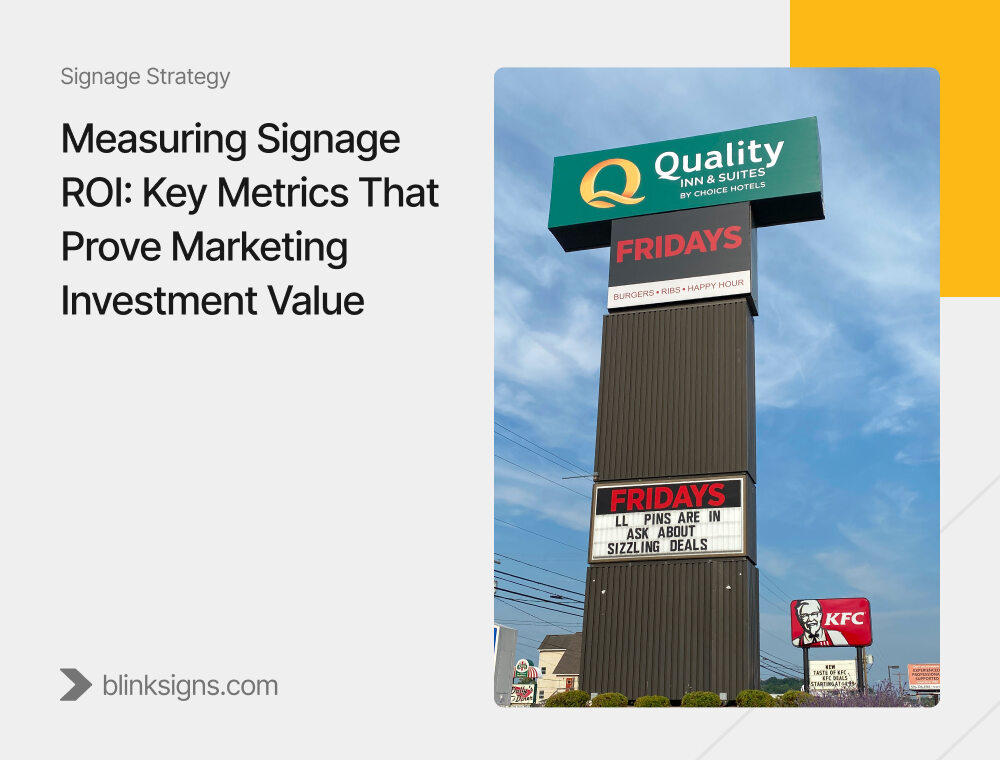
Measuring Signage ROI: Key Metrics That Prove Marketing Investment Value
Why Measuring Signage ROI Matters
Every business invests in signage, but not everyone knows if those signs are truly paying off. When budgets tighten, executives ask, “What did we get in return?” If you lack the answer, people may perceive your signage expenditure as a cost instead of a source of growth.
At BlinkSigns, we know signage is more than a visual asset—it’s a marketing investment that attracts customers, drives sales, and strengthens brand value. The key is proving it. Measuring signage ROI (Return on Investment) with the right metrics ensures your signs are creating impact and justifying every dollar spent.
Why ROI Measurement Matters for Business Signage
Signage has always been a business essential. It builds awareness, guides customers, and reinforces credibility. But today, ROI measurement takes it further. By tracking performance, businesses can:
- Defend marketing budgets with complex numbers.
- Compare signage ROI against digital ads, social media, or traditional marketing channels.
- Justify upgrades like LED retrofits or digital displays with measurable cost savings.
- Plan smarter investments in multi-location rollouts or rebrands.
Failing to measure ROI leads to missed opportunities. With clear metrics, signage moves from “must-have overhead” to a proven growth asset.
Core Metrics That Define Signage ROI
Visibility & Awareness Metrics
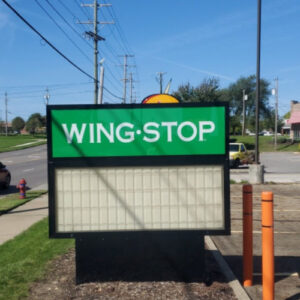
Wingstop Monument Signs
The first step in ROI measurement is visibility—did people actually see your sign? Businesses track:
- Impressions & Reach: Estimated audience exposure based on traffic counts or footfall analytics.
- Foot Traffic Lift: Sign visibility directly contributes to increased store visits.
- Brand Recall: Surveys or customer feedback showing whether signage influenced recognition.
Example: A monument sign on a high-traffic corridor can deliver thousands of daily impressions—making it one of the lowest cost-per-impression marketing tools available.
Engagement Metrics
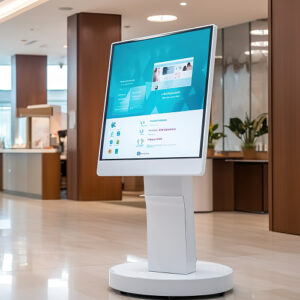
interactive lobby screen
Seeing a sign is one thing—engaging with it is another. Engagement metrics measure how effectively your signage holds attention.
- Dwell Time: How long do customers pause near your signage?
- Interaction Rate: QR code scans, touchscreen taps, or AR activations.
- Customer Engagement Tracking: AI-powered analytics showing behavioral responses.
Example: An interactive lobby screen that guides visitors to meeting rooms creates measurable engagement and improves customer experience simultaneously.
Conversion & Revenue Metrics
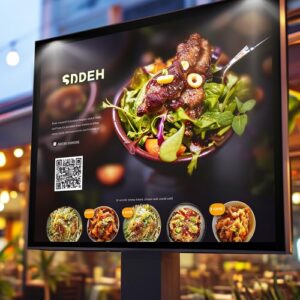
QSR digital menu board
The strongest ROI metric is conversion—did your signage influence sales or actions?
- Sales Uplift: Comparing sales before and after signage campaigns.
- Lead Generation: Tracking inquiries or sign-driven phone calls.
- Call-to-Action Response: Measuring how many people redeemed offers promoted on signage.
Example: A QSR chain measuring promo-driven sales from digital menu boards can directly attribute uplift to signage content.
Cost Efficiency Metrics
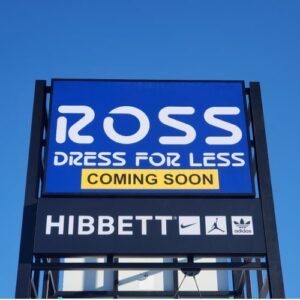
ROSS DRESS FOR LESS pylon sign
ROI isn’t only about revenue—it’s also about efficiency. Cost metrics prove signage is more affordable than many marketing alternatives.
- Cost-Per-Impression (CPI): Signage often beats digital and print regarding reach per dollar.
- Cost-Per-Lead (CPL): Signage-generated leads can reduce acquisition costs.
- Customer Acquisition Cost (CAC) Impact: Signs improve visibility, lowering overall acquisition costs over time.
Example: A pylon sign on a busy commercial road may generate impressions at a fraction of the cost of paid online campaigns.
Operational & Compliance Metrics

Healthcare wayfinding signage
Sometimes ROI is measured in avoided risks or efficiency gains.
- Wait-Time Reduction: Digital signs in lobbies or QSRs improve customer flow.
- Efficiency Improvements: Automated digital boards reduce staff workload.
- Compliance ROI: ADA-compliant signage prevents legal risks and enhances inclusivity.
Example: Healthcare facilities that update ADA wayfinding signage improve patient experience and reduce liability risks.
Tools & Technologies for Measuring Signage ROI
Modern signage is measurable thanks to analytics platforms and smart integrations. Businesses no longer have to guess whether their signs are working—technology provides complex data.
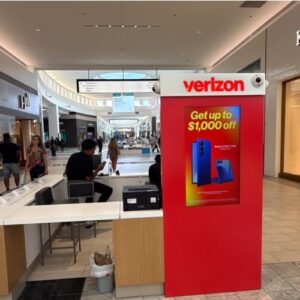
Verizon IoT-enabled digital displays
- Signage Analytics Platforms: Track impressions, engagement, and conversions with AI-powered dashboards.
- IoT-Enabled Monitoring: Sensors measure foot traffic, dwell time, and customer movement near signage.
- Predictive Analytics: Machine learning forecasts ROI by analyzing patterns in engagement and sales.
- Mobile Integration: QR codes, NFC tags, and geofencing link physical signage to mobile activity.
Example: A retailer integrating IoT-enabled sensors with digital displays can directly compare signage-driven visits against store sales data.
Industry-Specific ROI Insights
Retail & QSR (Quick Service Restaurants)
- Dynamic menu boards drive upsells and automate pricing updates.
- Storefront signage increases impulse visits from passing traffic.
- Higher average transaction values and faster service speeds demonstrate ROI.
Healthcare & Corporate Facilities
- Wayfinding signage reduces staff interruptions, saving time and labor costs.
- ADA compliance signage prevents legal risks, ensuring ROI through risk reduction.
- Corporate branding signage strengthens employee engagement and recruitment value.
Hospitality & Events
- Hotels measure ROI through improved guest experience scores.
- Event signage delivers ROI via sponsorship visibility and attendee engagement.
- Casinos and entertainment venues measure ROI through increased dwell time and repeat visits.
Transportation & Smart Cities
- Airports and metro hubs leverage digital boards for real-time communication.
- ROI is calculated through reduced customer service costs and higher passenger satisfaction.
Long-Term ROI: Beyond Immediate Sales
While revenue impact is critical, signage ROI extends to long-term savings and brand equity.
- Lifecycle Value: Quality signage lasts longer with preventive maintenance, reducing replacement costs.
- Maintenance Savings: Proactive care reduces emergency service costs by 30–40%.
- Energy Efficiency ROI: LED retrofits outperform fluorescent or neon signage, saving up to 80% energy use.
- Brand Equity: Professional, consistent signage builds lasting credibility that impacts customer retention.
Example: A franchise investing in consistent monument signs across all locations sees stronger recognition, reinforcing long-term brand equity.
Sustainability & ESG-Linked ROI
In 2025, ROI isn’t only financial—it’s also reputational. Businesses aligning with Environmental, Social, and Governance (ESG) principles gain measurable brand value.
- Eco-Friendly Materials: Durable, recyclable signage lowers long-term costs.
- Intelligent Lighting Systems: Reduce energy waste through automated dimming.
- Solar-Powered Signage: Cuts operating costs while strengthening sustainability reporting.
Businesses can demonstrate compliance, draw in eco-aware clients, and provide stakeholders with positive reports by linking signage ROI to sustainability metrics.
The BlinkSigns Approach to ROI Measurement
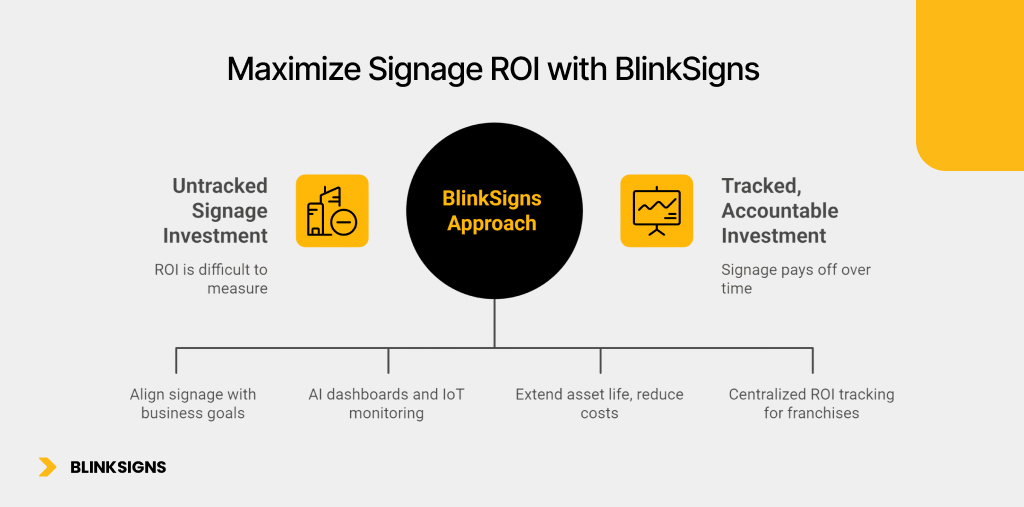
Maximize Signage ROI with BlinkSigns
At BlinkSigns, signage is a performance engine, not just a display. Our approach combines design, compliance, and technology to maximize ROI at every stage.
- Consultation & Strategy: We align signage solutions with business objectives.
- Technology Integration: AI dashboards, IoT monitoring, and data-driven reporting tools.
- Preventive Maintenance: Structured schedules that extend asset life and reduce costs.
- Multi-Location Expertise: Centralized ROI tracking for franchises and enterprises.
When you partner with BlinkSigns, your signage becomes a tracked, accountable investment that pays off over time.
FAQs: Measuring Signage ROI
Q1: How do you measure ROI from signage?
We measure the ROI from signage by tracking metrics such as visibility (impressions, foot traffic), engagement (dwell time, scans), and conversions (sales uplift, inquiries), and then comparing these results to the costs of signage.
Q2: What metrics prove signage effectiveness?
Key metrics include foot traffic lift, sales uplift, brand recall, and cost-per-impression (CPI). These show both financial and brand impact.
Q3: What is a realistic ROI benchmark for signage?
ROI varies by industry, but well-placed signage often delivers some of the lowest cost-per-impression rates across all marketing channels.
Q4: How does digital signage ROI compare to traditional signage?
Due to energy efficiency and dynamic content updates, digital signage offers more trackable data (engagement, conversions) and lower long-term operating expenses.
Q5: What industries see the highest ROI from signage?
Retail, QSR, hospitality, healthcare, and corporate facilities see strong returns, especially when signage integrates with customer experience and operational efficiency.
Turning Signage Into a Proven Investment
Signage is more than a marker—it’s a measurable marketing asset. By tracking the right metrics, businesses can prove that signs drive traffic, increase sales, cut costs, and protect brand credibility.
At BlinkSigns, we help organizations build signage strategies that deliver on both visibility and ROI. We ensure that every sign is visible, measured, optimized, and performing, from design and permitting to installation and long-term maintenance.
Your signage is already speaking for your business. With BlinkSigns, you can prove exactly what it’s saying—and how much value it delivers. Request a quote now ➡